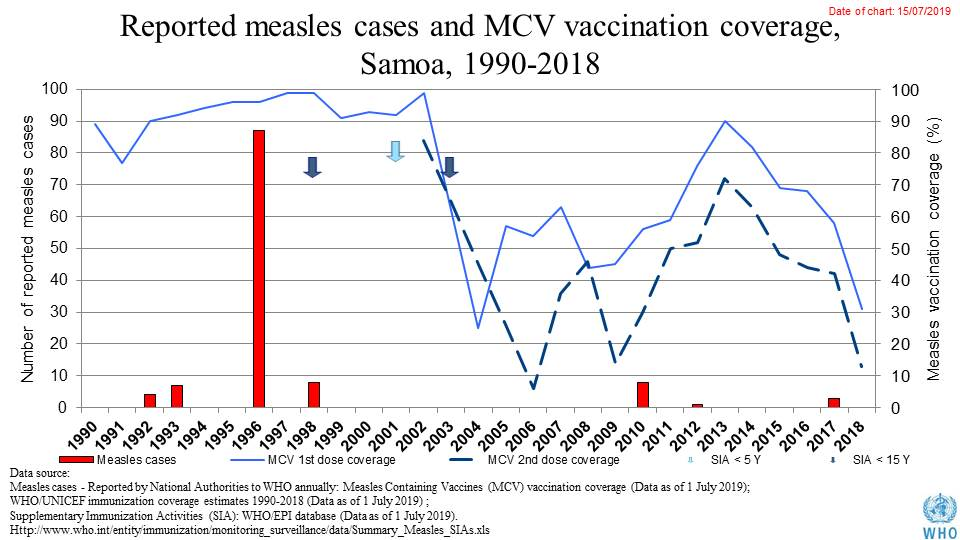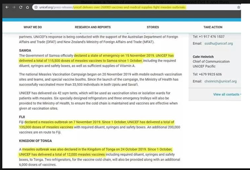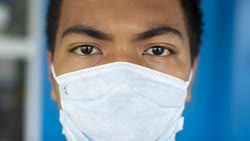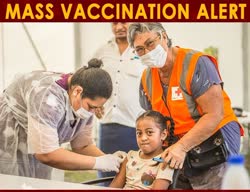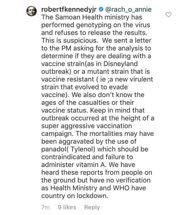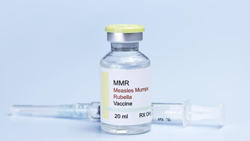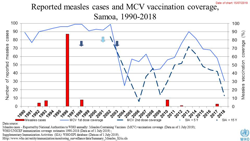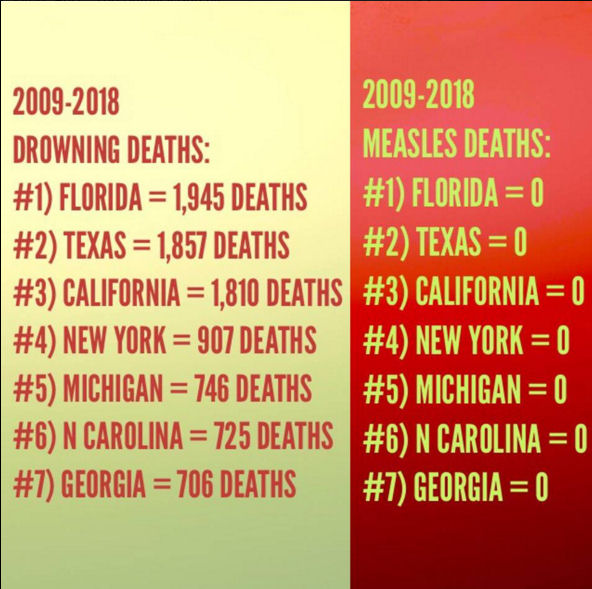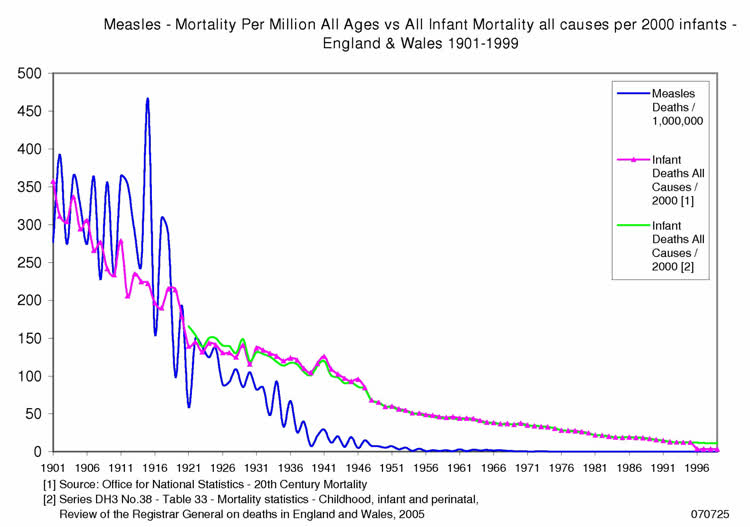|
Clinical Epidemiology of Sporadic Measles in a Highly Immunized Population.
Schaffner, W., Schluederberg, A. E. S., & Byrne, E. B. (1968). New England Journal of Medicine, 279(15), 783–789. doi:10.1056/nejm196810102791501
Half the cases were military dependants.
|
Exaggerated natural measles following attenuated virus immunization
An adolescent girl, devoid of detectable
humoral immunity to measles virus despite two
inoculations of live, attenuated vaccine, developed
an exaggerated atypical rubeola illness
following exposure to wild virus. This observation
suggests that attenuated virus may be capable of
immunologically sensitizing some individuals as
has been described with killed virus vaccine.
|
The vaccine induced an antibody response in about 95% of recipients
Measles and mumps immunization: benefit versus risk factors.
Measles and mumps are universal diseases that affect more than 90% of the population of most countries of the world. During the prevaccine era about 98% of young adults had serologic evidence of past measles infection. Although mumps infection was less prevalent, about 90% of persons were infected before they reached their 20th birthday. Before vaccines were available, measles and mumps were inevitable infections of childhood. Therefore, an assessment of the benefits and risks of immunization to prevent these diseases must also consider the consequences of naturally acquired measles and mumps infections.
PIP:
Both measles and mumps are universal diseases, affecting more than 90% of the population of most countries of the world. In the US, during the prevaccine era, about 500,000 cases of measles were reported each year. Since licensure of measles vaccine in 1963, about 70% of the population of infants and children have been immunized. This extensive use of vaccine has been associated with a progressive decline in the number of reported cases of measles, measles encephalitis, and subacute sclerosing panencephalitis (SSPE). By 1978, the reduction in incidence of measles will exceed 90%. The rising incidence of measles in older persons represents a risk of the present immunization program, but this risk can be eliminated by a more aggressive immunization program. Mumps, usually regarded as a relatively mild disease, is responsible for considerable morbidity in those children and adults who develop fever and painful parotid swelling during the course of the illness. A live attenuated mumps-virus vaccine was licensed for use in the US in January 1968. Experience with this vaccine, the Jeryl Lynn strain, revealed that it was well-tolerated, immunogenic, and protective. Local or systemic reactions rarely were observed; it did not cause fever, and side-effects were negligible. The vaccine induced an antibody response in about 95% of recipients, and persistence of antibody and protection were observed for the 2-year period before licensure. Since licensure of mumps vaccine in 1968, more than 36 million doses have been distributed. This extensive experience confirmed the safety and efficacy of the vaccine. It also revealed evidence of persistence of immunity. The use of more than 36 million doses of mumps vaccine in the US has been followed by a decrease in the number of reported cases from about 200,000 in the prevaccine era to about 20,000 this past year, a 90% reduction in the incidence of mumps.
|
The basic concept of herd immunity is directly applicable only under very special conditions.
Herd immunity and measles.
The basic concept of herd immunity is directly applicable only under very special conditions. The agents of disease must be restricted to a single host species within which transmission occurs by relatively direct contact, and infection induces solid immunity. Also outbreaks must occur only in randomly mixing populations. In free-living populations, susceptibles are not distributed homogeneously but tend to cluster in subgroups defined by age and by such factors as ethnicity and socioeconomic status. The requisite for occurrence of epidemics, namely a large enough number of susceptibles in frequent contact with each other, exists in virtually all large populations, regardless of the total proportion of the population that is immune. Experience with measles illustrates these conditions. Total prevalence of immunity of greater than or equal to 90% in developing countries does not prevent annual epidemics among the susceptibles, most of whom are children younger than three years of age. Where vaccination is widely practiced, as in the United States since 1962, measles has continued to occur in poorly immunized subgroups that are characterized by low educational level and economic status, very young age, or religious beliefs forbidding acceptance of vaccine. Ultimate success of a systematic immunization program requires knowledge of distribution of susceptibles by age and subgroup and maximal effort to reduce the concentration of susceptibles throughout the community rather than aiming to reach any specific proportion of the overall population.
|
The proportion of susceptibles in the year 2050 may be greater than in the prevaccine era. Present vaccine technology and public health policy must be altered to deal with this eventuality.
The future of measles in highly immunized populations. A modeling approach.
Little is known about how an intensive measles elimination program changes the overall immune status of the population. A computer model was created to study the effect of the measles elimination program in the United States on the number of susceptibles in the population. The simulation reveals that in the prevaccine era, approximately 10.6% of the population was susceptible to measles, most of whom were children less than 10 years of age. With the institution of the measles immunization program, the proportion of susceptibles in the population fell to 3.1% from 1978 through 1981, but then began to rise by approximately 0.1% per year to reach about 10.9% in the year 2050. The susceptibles at this time were distributed evenly throughout all age groups. The model did not consider the potential effect of waning immunity. The results of this study suggest that measles elimination in the United States has been achieved by an effective immunization program aimed at young susceptibles combined with a highly, naturally immunized adult population. However, despite short-term success in eliminating the disease, long-range projections demonstrate that the proportion of susceptibles in the year 2050 may be greater than in the prevaccine era. Present vaccine technology and public health policy must be altered to deal with this eventuality.
|
"Several lineages of measles virus can be found to co-circulate at a given time."
Measles virus (MV) is a monotypic virus which has been
considered extraordinarily stable in terms of its serology
and immune responses to it. However, analysis of the
ability of different strains of the virus to bind monoclonal
antibodies has revealed a low level of variability in the
major antigens (Sheshberadaran et al., 1983) and, more
recently, strain variations have been studied directly by
analysis of the nucleotide sequences of MV strains (data
compiled in Cattaneo et al., 1989).
|
If vaccine efficacy is reduced because of poor vaccine storage or handling, large outbreaks may occur
Measles control in developing countries
The EPI has made significant progress in reducing global morbidity and mortality from measles. Many countries are considering the need for additional strategies in response to the changes in measles epidemiology which occur when vaccination coverage increases. Measles vaccination changes the relative age distribution of cases towards older groups, because measles transmission becomes less intense so that children reach older ages before being exposed to wild virus. The proportion of cases occurring below the target age group for vaccination may also increase, though the number of cases does not always increase. Outbreaks are likely to occur after some years of low incidence in countries which have moderate or high coverage, for several reasons. Firstly, susceptibles gradually accumulate over a number of years until a "post-honeymoon" outbreak occurs. Second, there may be pockets of low coverage which occur for example in urban slums, in nomadic and other inaccessible populations, or among groups with religious or philosophical objections to vaccination. Third, outbreaks can occur among vaccinated children who did not respond to the vaccine. Even in industrialized countries, where measles vaccine is administered in the second year of life and is over 90% effective in protecting against disease, small outbreaks have occurred among vaccine failures under conditions of close contact such as school settings. In developing countries, where measles vaccine is usually administered at age 9 months, approximately 15% of children are not protected, and vaccine failures can be expected to play an increasing role in outbreaks in the future. Furthermore, if vaccine efficacy is reduced because of poor vaccine storage or handling, large outbreaks may occur.
|
The majority of measles cases occur in appropriately immunized children
(In 1963 vaccination for measles began. By 1994 it was clear mostly vaccinated patients were getting measles. The decision was hen made to use two shots. Unmentioned was the doubled risk of getting the disease from the shot itself)
Failure to reach the goal of measles elimination. Apparent paradox of measles infections in immunized persons.
Abstract
BACKGROUND:
Measles is the most transmissible disease known to man. During the 1980s, the number of measles cases in the United States rose dramatically. Surprisingly, 20% to 40% of these cases occurred in persons who had been appropriately immunized against measles. In response, the United States adopted a two-dose universal measles immunization program. We critically examine the effect of vaccine failure in measles occurring in immunized persons.
METHODS:
We performed a computerized bibliographic literature search (National Library of Medicine) for all English-language articles dealing with measles outbreaks. We limited our search to reports of US and Canadian school-based outbreaks of measles, and we spoke with experts to get estimates of vaccine failure rates. In addition, we devised a hypothetical model of a school where measles immunization rates could be varied, vaccine failure rates could be calculated, and the percentage of measles cases occurring in immunized students could be determined.
RESULTS:
We found 18 reports of measles outbreaks in very highly immunized school populations where 71% to 99.8% of students were immunized against measles. Despite these high rates of immunization, 30% to 100% (mean, 77%) of all measles cases in these outbreaks occurred in previously immunized students. In our hypothetical school model, after more than 95% of schoolchildren are immunized against measles, the majority of measles cases occur in appropriately immunized children.
CONCLUSIONS:
The apparent paradox is that as measles immunization rates rise to high levels in a population, measles becomes a disease of immunized persons. Because of the failure rate of the vaccine and the unique transmissibility of the measles virus, the currently available measles vaccine, used in a single-dose strategy, is unlikely to completely eliminate measles. The long-term success of a two-dose strategy to eliminate measles remains to be determined.
|
Total protection against measles might not be achievable, even among revaccinees, when children are confronted with intense exposure to measles virus.
Explosive school-based measles outbreak: intense exposure may have resulted in high risk, even among revaccinees.
Even high levels of measles vaccination coverage have not always prevented outbreaks of measles spread by airborne transmission. It has been suggested that a large inoculum might increase vaccine failure risk. Airbome transmission might occasionally entail a large measles inoculum. The epidemiologic relevance of measles among properly vaccinated persons (i.e., those vaccinated after 15 months of age and with live attenuated virus) is increased when they become contagious. The authors studied inoculum intensities as measured by proxy variables and the contagiousness of properly vaccinated persons who contracted measles among 51 measles patients infected in one school, at home, or elsewhere, utilizing preexisting records of measles cases and 214 healthy controls from an explosive school outbreak that occurred in a rural Finnish municipality in 1989. One "super-spreader" infected 22 others in one day, including eight once-vaccinated students and one twice-vaccinated student, probably during an assembly of 144 students in a poorly ventilated hallway with no sunlight. Those infected later at home had high measles risk, even if they were revaccinees. When siblings shared a bedroom with a measles case, a 78 percent risk (seven out of nine children) was observed among vaccinees. Vaccinees had approximately 2 days' shorter incubation time than unvaccinated persons. Vaccinated and unvaccinated students were equally able to infect their siblings. Total protection against measles might not be achievable, even among revaccinees, when children are confronted with intense exposure to measles virus.
|
The H Gene of Rodent Brain-Adapted Measles Virus Confers Neurovirulence to the Edmonston Vaccine Strain
Molecular determinants of neuropathogenesis have been shown to be present in the hemagglutinin (H) protein of measles virus (MV). An H gene insertion vector has been generated from the Edmonston B vaccine full-length infectious clone of MV. Using this vector, it is possible to insert complete H open reading frames into the parental (Edtag) background. The H gene from a rodent brain-adapted MV strain (CAM/RB) was inserted into this vector, and a recombinant virus (EdtagCAMH) was rescued by using a modified vaccinia virus which expresses T7 RNA polymerase (MVA-T7). The recombinant virus grew at an equivalent rate and to similar titers as the CAM/RB and Edtag parental viruses. Neurovirulence was assayed in a mouse model for MV encephalitis. Viruses were injected intracerebrally into the right cortex of C57/BL/6 suckling mice. After infection mice inoculated with the CAM/RB strain developed hind limb paralysis and ataxia. Clinical symptoms were never observed with an equivalent dose of Edtag virus or in sham infections. Immunohistochemistry (IHC) was used to detect viral antigen in formalin-fixed brain sections. Measles antigen was observed in neurons and neuronal processes of the hippocampus, frontal, temporal, and olfactory cortices and neostriatum on both sides of symmetrical structures. Viral antigen was not detected in mice infected with Edtag virus. Mice infected with the recombinant virus, EdtagCAMH, became clinically ill, and virus was detected by IHC in regions of the brain similar to those in which it was detected in animals infected with CAM/RB. The EdtagCAMH infection had, however, progressed much less than the CAM/RB virus at 4 days postinfection. It therefore appears that additional determinants are encoded in other regions of the MV genome which are required for full neurovirulence equivalent to CAM/RB. Nevertheless, replacement of the H gene alone is sufficient to cause neuropathology.
|
Altered Virulence of Vaccine Strains of Measles Virus after Prolonged Replication in Human Tissue
"...a virus isolated from an immunodeficient child with progressive vaccine-induced disease (Hu2)."
"...pMor-1, Hu2, and Ed-wt displayed virulent phenotypes in thymic implants, with high levels of virus being detected by 3 days after infection (105.2, 102.8, and 103.4, respectively) and maximal levels being detected between 7 and 14 days after infection. In contrast, Moraten required over 14 days to grow to detectable levels. pMor-1 produced the highest levels of virus throughout infection, suggesting thymic adaptation of this strain. Similar to other virulent strains, Ed-wt, Hu2, and pMor-1 caused a decrease in the number of viable thymocytes as assessed by trypan blue exclusion and fluorescence-activated cell sorter analysis."
"However, fatal infections have been documented in immunodeficient children vaccinated with these strains..."
"Hu2, an MV strain isolated from a child with congenital immunodeficiency who died of disseminated measles after immunization with the Schwarz vaccine (12), has enhanced virulence in thy/liv implants. Both strains showed increased virulence in the thy/liv model"
|
"Serum collected 13 days after MMR was measles PCR positive"
MMR vaccine in HIV-infected children — potential hazards?
"The serum collected 13 days after MMR was measles PCR positive by both a validated in-house method [3] and at a commercial laboratory
(Micropathology Ltd.). Results of tests for evidence of infection by other rash causing viruses were negative: PCR for enterovirus RNA, HHV-6 DNA, adenovirus DNA, mumps RNA and rubella RNA (Micropathology Ltd.) and dot blot and IgM assays for parvovirus B19 (PHLS Colindale) were all negative. The sequence of nucleic acids amplified by PCR was identical to published sequences (GenBank) of measles vaccine strains derived from the Enders isolate of Edmonston
virus [4]. These are the strains currently used in the UK in measles vaccines including the MMR II™ vaccine (Aventis-Pasteur) received by the patient described in this report"
"The statement by the American Academy of Paediatrics
[10] does not recommend giving live attenuated
measles vaccine to severely immunosuppressed HIVinfected
patients as defined in Table 2, because they
do not respond well to measles vaccine and there is
some risk of serious complications."
|
"The overall risk of aseptic meningitis following the MMR campaign was increased 12.2-fold"
We estimated a risk of 2.9 cases per 10 000 doses of L-Z administered, equivalent to 1 case per 3390 doses administered. The overall risk of aseptic meningitis following the campaign was increased 12.2-fold (95% CI: 6.0–24.7) compared with the same period in 1995–1996. Following the mass campaign, the incidence of mumps declined 93% during 1998–2000
|
Of 9 sick kids, 2 had no shots, 1 had one, 6 had two shots
A limited measles outbreak in a highly vaccinated US boarding school.
Abstract
OBJECTIVES:
We investigated a measles outbreak that began in March 2003 in a Pennsylvania boarding school with >600 students to identify all cases, including the source; implement outbreak control measures; and evaluate vaccine effectiveness.
METHODS:
Measles was suspected in any person at the school with a generalized rash and fever during March 21 to May 28, 2003 and investigated with serologic testing. We reviewed vaccination history from school records and conducted a survey to determine country of measles vaccination. Vaccine effectiveness was calculated using the cohort method.
RESULTS:
We identified 9 laboratory-confirmed cases at the school: 8 students and 1 staff member. Among them, 2 had never received any doses of measles-containing vaccine (MCV), 1 received 1 dose of MCV, and 6 received 2 doses of MCV. Three of the 6 who received 2 doses of MCV received both doses outside the United States. The source case had been infected in Lebanon. Two laboratory-confirmed spread cases were identified in New York City. Measles virus of genotype D4 was isolated in cases from the school and New York City. Of the 663 students in the school, 8 (1.2%) had never received any doses of MCV, 26 (3.9%) had received 1 dose, and 629 (94.9%) had received 2 doses before the outbreak. Vaccine effectiveness among students who had received 2 doses of MCV was 98.6%. However, students who received both doses outside the United States had a higher attack rate (3 of 75) than those who received both doses in the United States (3 of 509; rate ratio: 6.8; 95% confidence interval: 1.4-33.0).
CONCLUSIONS:
This is the largest measles outbreak to occur in a school in the United States since 1998, but it was limited to only 9 cases in a boarding school with >600 students. The limited extent of this outbreak highlights the high level of population immunity achieved in the United States through widespread implementation of a 2-dose measles-mumps-rubella vaccination strategy in school-aged children. States and schools should continue to enforce strictly the 2-dose measles-mumps-rubella vaccination requirement and, in an outbreak setting, consider revaccinating students who received measles vaccine outside of the United States. Continued vigilance by health care providers is needed to recognize measles cases.
|
Global measles elimination
"Measles virus (MV) is highly infectious, requiring a high level of population immunity to interrupt transmission, and might be more difficult to eliminate in regions of high population density and high prevalence of human immunodeficiency virus type 1 (HIV-1) infection."
"The ideal measles vaccine would be inexpensive, safe, heat-stable, immunogenic in neonates or very young infants, administered as a single dose without needle or syringe, and would not prime individuals for atypical measles or be associated with prolonged immunosuppression. Several vaccine candidates with some of these characteristics are undergoing development."
|
Measles and mumps viral strain-containing vaccines and hearing loss, 1990-2003
Hearing loss (HL) is a known complication of wild measles and mumps viral infections. As vaccines against measles and mumps contain live attenuated viral strains, it is biologically plausible that in some individuals HL could develop as a complication of vaccination against measles and/or mumps. Our objectives for this study were: to find and describe all cases of HL reported in the scientific literature and to the US Vaccine Adverse Events Reporting System (VAERS) for the period 1990--2003; and to determine reporting rate of HL after live attenuated measles and/or mumps viral strain-containing vaccines (MMCV) administration. We searched published reports for cases of HL identified after vaccination with MMCV. We also searched for reports of HL after MMCV administration submitted to VAERS from 1990 through 2003 and determined the dose-adjusted reporting rate of HL. Our main outcome measure was reported cases of HL after immunization with MMCV which were classified as idiopathic. We found 11 published case reports of HL following MMCV. The review of the VAERS reports identified 44 cases of likely idiopathic sensorineural HL after MMCV administration. The onset of HL in the majority of VAERS and published cases was consistent with the incubation periods of wild measles and mumps viruses. Based on the annual usage of measles-mumps-rubella (MMR) vaccine, we estimated the reporting rate of HL to be 1 case per 6-8 million doses. Thus, HL following MMCV has been reported in the literature and to the VAERS. Further studies are needed to better understand if there is a causal relationship between MMCV and HL.
|
|
|
|
Out of the 18 patients in the three villages, viz., Jathrear, Bathrear and Gujrear, 14 (78%) patients were immunized
So 78% of the kids that got measles were immunized.
"The vaccine efficacies were estimated to be 85% and 81% in the first and second outbreaks respectively. Eleven of the 16 case patients were tested for measles IgM antibodies, while two nasopharyngeal swabs were positive by polymerase chain reaction (PCR) and are genotyped D4 measles strain. Vitamin A supplementations were only given in four villages."
Which works better, Vit. A or the vaccine?
|
Risk
analysis
for
measles
reintroduction
post
global
certification
of
eradication (W.H.O.)
"Mild or asymptomatic measles infections are probably very common"
|
Vaccine instability in the cold chain: Mechanisms, analysis and formulation strategies
These include live, attenuated (measles, polio) and inactivated (influenza, polio) viral vaccines as well as recombinant protein (hepatitis B) vaccines.
|
Measles Outbreak Traced to Fully Vaccinated Patient for First Time
By Nsikan AkpanApr. 11, 2014 , 12:00 PM
"That’s why a fully vaccinated 22-year-old theater employee in New York City who developed the measles in 2011 was released without hospitalization or quarantine. But like Typhoid Mary, this patient turned out to be unwittingly contagious. Ultimately, she transmitted the measles to four other people, according to a recent report in Clinical Infectious Diseases that tracked symptoms in the 88 people with whom “Measles Mary” interacted while she was sick. Surprisingly, two of the secondary patients had been fully vaccinated. And although the other two had no record of receiving the vaccine, they both showed signs of previous measles exposure that should have conferred immunity."
|
Outbreak of Measles Among Persons With Prior Evidence of Immunity, New York City, 2011
Measles was eliminated in the United States through high vaccination coverage and a public health system able to rapidly respond to measles. Measles may occur among vaccinated individuals, but secondary transmission from such individuals has not yet been documented.
This report documents measles transmission from an individual with verified secondary vaccine failure.
This was the famous "Measles Mary" case covered in the media.
|
The Emerging Risks of Live Virus &
Virus Vectored Vaccines:
Vaccine Strain Virus Infection, Shedding & Transmission
Excretion of small amounts of the live attenuated rubella virus from the nose or
throat has occurred in the majority of susceptible individuals 7 to 28 days after
vaccination. There is no confirmed evidence to indicate that such virus is
transmitted to susceptible persons who are in contact with the vaccinated
individuals. Consequently, transmission through close personal contact, while
accepted as a theoretical possibility, is not regarded as a significant risk.
However, transmission of the rubella vaccine virus to infants via breast milk has
been documented.”
"In 2013, Eurosurveillance published a report of vaccine strain measles occurring weeks
after MMR vaccination in Canada. Authors stated, “We describe a case of measlesmumps-rubella
(MMR) vaccine-associated measles illness that was positive by both
PCR and IgM, five weeks after administration of the MMR vaccine.” The case involved a
two-year-old child, who developed runny nose, fever, cough, macular rash and
conjunctivitis after vaccination and tested positive for vaccine strain measles virus
infection in throat swab and blood tests.
Canadian health officials authoring the report raised the question of whether there are
unidentified cases of vaccine strain measles infections and the need to know more
about how long measles vaccine strain shedding lasts. They concluded that the case
they reported ”likely represents the existence of additional, but unidentified, exceptions
to the typical timeframe for measles vaccine virus shedding and illness.” They added
that “further investigation is needed on the upper limit of measles vaccine virus
shedding based on increased sensitivity of the RT-PCR-based detection technologies
and immunological factors associated with vaccine-associated measles illness and virus
shedding.”
|
Laboratory confirmation of rubella infection in suspected measles cases.
As a part of measles outbreak based surveillance undertaken by the World Health Organization India, suspected measles cases were referred for the laboratory diagnosis at National Institute of Virology (NIV) Pune and NIV Unit Bengaluru. Altogether, 4,592 serum samples were referred during 2010-2015 from the States of Karnataka (n = 1,173), Kerala (n = 559), and Maharashtra (n = 2,860). Initially, serum samples were tested in measles IgM antibody EIA and samples with measles negative and equivocal results (n = 1,954) were subjected to rubella IgM antibody detection. Overall, 62.9% (2,889/4,592) samples were laboratory confirmed measles, 27.7% (542/1,954) were laboratory confirmed rubella and remaining 25.2% (1,161/4,592) were negative for measles and rubella. The measles vaccination status was available for 1,206 cases. Among the vaccinated individuals, 50.7% (612/1,206) were laboratory confirmed measles. The contribution of laboratory confirmed measles was 493 (40.8%) from Maharashtra, 90 (7.5%) from Karnataka, and 29 (2.4%) from Kerala. Since, 1/3rd of suspected measles cases were laboratory confirmed rubella, an urgent attention needed to build rubella surveillance in India. Additional efforts are required to rule out other exanthematous disease including Dengue and Chikungunya in measles and rubella negatives.
|
Antigenic Drift Defines a New D4 Subgenotype of Measles Virus
The measles virus hemagglutinin (MeV-H) protein is the main target of protective neutralizing antibodies. Using a panel of monoclonal antibodies (MAbs) that recognize known major antigenic sites in MeV-H, we identified a D4 genotype variant that escapes neutralization by MAbs targeting the neutralizing epitope (NE) antigenic site. By site-directed mutagenesis, L249P was identified as the critical mutation disrupting the NE in this genotype D4 variant. Forty-two available D4 genotype gene sequences were subsequently analyzed and divided into 2 groups according to the presence or absence of the L249P MeV-H mutation. Further analysis of the MeV-N gene sequences of these 2 groups confirmed that they represent clearly definable, sequence-divergent D4 subgenotypes, which we named subgenotypes D4.1 and D4.2. The subgenotype D4.1 MeVs were isolated predominantly in Kenya and Ethiopia, whereas the MAb-resistant subgenotype D4.2 MeVs were isolated predominantly in France and Great Britain, countries with higher vaccine coverage rates. Interestingly, D4.2 subgenotype viruses showed a trend toward diminished susceptibility to neutralization by human sera pooled from approximately 60 to 80 North American donors. Escape from MAb neutralization may be a powerful epidemiological surveillance tool to monitor the evolution of new MeV subgenotypes.
|
measles virus (MeV) was interrupted in the Americas in 2002. Wild-type viruses of genotype A are no longer circulating.
Rapid Identification of Measles Virus Vaccine Genotype by Real-Time PCR
DOI: 10.1128/JCM.01879-16
o During measles outbreaks, it is important to be able to rapidly distinguish between measles cases and vaccine reactions to avoid unnecessary outbreak response measures such as case isolation and contact investigations.
o Endemic transmission of measles virus (MeV) was interrupted in the Americas in 2002
o approximately 5% of recipients of measles virus-containing vaccine experience rash and fever which may be indistinguishable from measles
o During the measles outbreak in California in 2015, a large number of suspected cases occurred in recent vaccinees
o Of the 194 measles virus sequences obtained in the United States in 2015, 73 were identified as vaccine sequences (R. J. McNall, unpublished data). In contrast, only 11 of 542 cases genotyped in the National Reference Center for Measles, Mumps, and Rubella in Germany were associated with the vaccine virus.
o Genotyping is used to confirm the origin of an outbreak and to exclude endemic circulation, but it is also the only way to distinguish vaccine strains from wild-type viruses.
The WHO currently recognizes 24 genotypes of measles virus, and all of the vaccine strains are in a single genotype, genotype A. Wild-type viruses of genotype A are no longer circulating (11).
o Genotyping is used to confirm the origin of an outbreak and to exclude endemic circulation, but it is also the only way to distinguish vaccine strains from wild-type viruses.
|
Measles was declared eliminated from the United States in 2000
In 1978, CDC set a goal to eliminate measles from the United States by 1982. Although this goal was not met, widespread use of measles vaccine drastically reduced the disease rates. By 1981, the number of reported measles cases was 80% less compared with the previous year. However, a 1989 measles outbreaks among vaccinated school-aged children prompted the Advisory Committee on Immunization Practices (ACIP), the American Academy of Pediatrics (AAP), and the American Academy of Family Physicians (AAFP) to recommend a second dose of MMR vaccine for all children. Following widespread implementation of this recommendation and improvements in first-dose MMR vaccine coverage, reported measles cases declined even more.
Measles was declared eliminated (absence of continuous disease transmission for greater than 12 months) from the United States in 2000. This was thanks to a highly effective vaccination program in the United States, as well as better measles control in the Americas region
|
Outbreak of over 12000 cases of measles in Ukraine is caused by recent vaccination campaign
In recent years there has been a shortage of measles vaccines in Ukraine. Vaccination rates had dropped to 31% in 2016 and were the lowest in Europe. And yet there were hardly any cases of measles. In 2017 sufficient vaccines became available for a ‘catch-up campaign’ and 90% of the children in Ukraine received the MMR. Since then there has been an explosion of cases of measles.
|
Unknowns with the measles vaccine
"Attenuation is associated with decreased replication in lymphoid tissue, but the molecular basis for this restriction has not been identified."
"Protective immunity is correlated with levels of neutralizing Ab, but the actual immunologic determinants of protection are not known."
|
Recommendations for Vit C in treating measles.
|
Documented cased of measles from the vaccine
These are cases from medical journals where the vaccine itself caused the measles. In some cases, people died from this.
|
2019 Outbreak of Measles in the Western Pacific Islands
New Zealand, Tonga, Samoa, Fiji have all had nasty outbreaks of the Measles in late 2019. It seems the more they vaccine the greater the number of measles cases.
|
|
|

